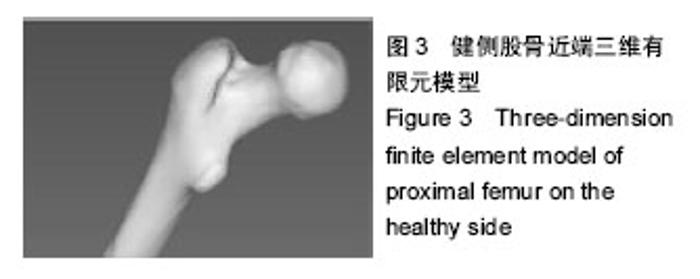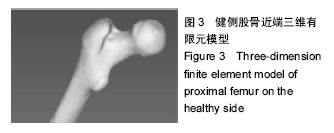| [1] Mangiafico RA,Russo E,Riccobene S,et al. Increased Prevalence of Peripheral Arterial Disease in Osteoporotic Postmenopausal Women. Bone Miner Metab. 2006;24:125-131.
[2] Mithal A, Bansal B, Kyer CS, et al. The Asia-Pacific Regional Audit-Epidemiology, Costs, and Burden of Osteoporosis in India 2013: A report of International Osteoporosis Foundation. Indian J Endocrinol Metab. 2014;18(4):449-454.
[3] Farhat GN,Strotmeyer ES,Newman AB. Volumetric and Areal Bone Mineral Density Measures Are Associated with Cardiovascular Disease in Older Men and Women: the Health, Aging, and Body Composition Study. Calcif Tissue Int. 2006;79(2):102-111.
[4] Cooper C,Campion G,Melton LJ. Hip fractures in the elderly: a world-wide projection. Osteoporos Int. 1992; 2(6):285- 289.
[5] 林松青,王彬,张磊,等.有限元分析在骨科中的应用及研究进展[J].中国中医骨伤科杂志,2013,21(4):69-73.
[6] 董谢平,张琳琳,何剑颖,等.髋保护器防护髋部骨折的有限元建模与分析[J].中国矫形外科杂志,2011,19(18): 1537-1541.
[7] 周筑宝,卢楚芬.连续损伤力学的几个基本问题[J].湘潭大学自然科学学报,1989, 11(4): 24-33.
[8] 安兵兵,李凯,张东升.皮质骨断裂力学行为的实验研究[J]. 力学学报,2010,54(6):1164-1171.
[9] 陈海树,赖征海,邸建卫. LS-DYNA在汽车碰撞模拟过程中的应用[J].沈阳大学学报,2006,18(4):10-12.
[10] 张冬茵,金星,丁海平,等. ANSYS/LS-DYNA在地震工程中的应用[J].地震工程与工程振动,2005,25(4):170-173.
[11] 杨超,杜来林.基于ANSYS/LS-DYNA的有限元动力分析应用[J]. 机电产品开发与创新,2011,24(1):121-122.
[12] 董海东,葛正浩.基于ANSYS/LS-DYNA的产品跌落仿真[J].洛阳理工学院学报(自然科学版),2010,20(3): 35-39.
[13] 李凡,粟思橙,胡伟,等.基于本构模型参数的肌肉主动力响应有限元分析[J]. 湖南大学学报:自然科学版, 2014, 41(10): 49-54.
[14] 粟思橙.基于肌肉主动力的颈部有限元建模研究[D].湖南大学,2014.
[15] 林梓凌,李鹏飞,庞智晖,等.骨密度与老年髋部骨折股骨近端三维有限元模型密度的关系[J].中国老年学杂志,2015, 35(11):3069-3070.
[16] 彭睿.行人在汽车碰撞事故中下肢骨折的有限元仿真研究[D].湖南大学,2006.
[17] Lin ZL, Li PF, Pang ZH, et al. Influence of Regional Difference in Bone Mineral Density on Hip Fracture Site in Elderly Females byFinite Element Analysis. Cell Biochem Biophys. 2015;73(2):405-412.
[18] Keyak JH. Improved prediction of proximal femoral fracture load using nonlinear finite element models. Med Eng Phys. 2001;23: 165-73.
[19] 樊黎霞,Eric Wang.人在摔倒时股骨上端承载能力的有限元分析——(I)有限元分析模型及股骨失效准则的建立[J]. 生物医学工程学杂志,2006,23(5):1028-1032.
[20] 孙培栋.侧方跌倒高度及髋保护器对髋部冲击影响的实验及有限元分析[D].南方医科大学,2012.
[21] 李正东,邹冬华,刘宁国,等.人体骨盆有限元模型的建立及其在法医学鉴定中的应用价值[J].法医学杂志, 2010, 26(6): 406-412.
[22] 彭国常.股骨颈区的应力研究、受伤姿势与股骨颈骨折成型的相关性分析[D].苏州大学,2007.
[23] Hambli R, Allaoui S. A robust 3D finite element simulation of human proximal femur progressive fracture under stance load with experimental validation. Ann Biomed Eng. 2013;41: 2515-2527.
[24] Mengoni M, Ponthot JP. An enhanced version of a bone-remodelling model based on the continuum damage mechanics theory. Comput Methods Biomech Biomed Engin. 2015;18: 1367-1376.
[25] 连志强.骨骼材料与结构的性能仿真及重建模拟研究[D].大连理工大学,2010.
[26] 马信龙,付鑫,马剑雄,等.股骨头内松质骨空间分布和力学性能变化有限元分析[J]. 医用生物力学,2010,25(6): 465-470.
[27] 袁高翔,张伟滨.有限元分析在骨骼肌肉系统模型材料特性研究中的应用[J]. 国际骨科学杂志,2011,32(6): 352-355.
[28] Peng L, Bai J, Zeng X, et al. Comparison of isotropic and orthotropic material property assignments on femoral finite element models under two loading conditions. Med Eng Phys. 2006;28: 227-233.
[29] 杨海胜.股骨材料属性有限元模拟及生物力学分析[D].哈尔滨工业大学,2008.
[30] Mustafy T, El-Rich M, Mesfar W, et al. Investigation of impact loading rate effects on the ligamentous cervical spinal load-partitioning using finiteelement model of functional spinal unit C2-C3. J Biomech. 2014;47: 2891-903.
[31] 张明华,叶军,邹宏恩,等.牛骨骨小梁疲劳的微观损伤[J].第四军医大学学报, 1999,20(12):1078-1080.
[32] Seref-Ferlengez Z, Kennedy OD, Schaffler MB. Bone microdamage, remodeling and bone fragility: how much damage is too much damage? Bone Key Rep. 2015;4: 644.
[33] 戴如春,石泽梅,李瑾宁.骨微损伤累积与修复[J].药物与临床,2015,12(8):13-15.
[34] 郭涛,张亚奎,张星火,等.股骨近端三维有限元模型评价髋部骨折患者骨密度[J].现代生物医学进展,2015,15(28): 5484-5486.
[35] 高甲子.老龄骨退化机理及振动促进骨折愈合的多尺度实验研究[D].吉林大学,2015.
[36] 王欣.髋部骨折植入物的选择及其并发症[J].中国组织工程研究,2015,19(48):7811-7818.
[37] 陈鹏,刘文和,颜林淋,等. 影响老年骨质疏松性髋部骨折术后功能康复的相关因素初探[J].生物技术世界,2015, 12(12):58-60.
[38] 欧阳小平,范伯骞,丁硕.助力型下肢外骨骼机器人现状及展望[J].科技导报,2015,33(23):92-99.
[39] 李平.不同跌倒姿势与髋部应力变化关系的有限元分析[D].广州中医药大学,2014.
[40] 吕林蔚. 股骨近端结构形态对其强度影响的生物力学数值仿真研究[D].吉林大学,2014.
[41] 张伊卓,宋雅伟,卞雯文.股骨颈的实验力学研究[J]. 中国骨质疏松杂志,2015,21(9):1065-1068. |



